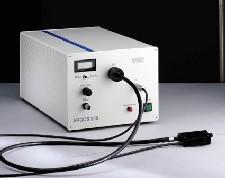|
Instrument Database:
Prince Technologies B.V. - Argos 250B Fluorescence Detector
| |
|

|
| |
|
| |
|
| Year of introduction |
|
| Status |
available |
| Company |
Prince Technologies B.V.
|
| Categories |
Spectrometer ( Molec. ): Fluorescence
|
Fluorescence detection should be considered if concentrations are too low. It can also be a powerful method of detection if a fluorescent sample cannot be separated well enough from a UV absorbing sample matrix. Prince Technologies offers the Argos 250 B with a high sensitive fibre optics special designed CE cell, which fits nicely into the PrinCE oven compartment.
Some Features of the Argos 250B fluorescence Detector
- High Sensitive Special designed fibre optics remote CE cell
- Broad wavelength range
Broad wavelength range
The Argos uses a special lamp that has a continuum spectrum in the UV-VIS range. On top of this continuum there are four wavelengths that have a very high intensity. When these are used as the excitation light beam the best limits of detection can be expected.
High Sensitive Special designed fibre optics remote CE cell
A special CE cell has been designed that ensures a very high gain of the fluorescence light that is generated inside the capillary, due to the excitation light beam. The combination of the high light intensity and the patented CE cell has resulted in the creation of a more sensitive conventional fluorescence detector. The cell is connected to the instrument by light fibres., This allows temperature control.
Optical principle of Argos 250B
The fluorescent light is totally reflected within the capillary in a down-stream direction. This is then diverted by a glass ellipsoid, sleeved over the capillary, at the downstream end of the optical window. In order to allow emitted light to leave the capillary window at the ellipsoid ‘s 1st focus, optical contact is established by applying a tiny amount of glycerol, which is held in the contact area capillary force. Fluorescence light which is “tapped” in this way, by the ellipsoid, is deflected to its 2nd focus and conducted from there to the photo-multiplier in the detector by the emission light guide. In order to keep the optical path free for the emission light guide, the capillary is bent out of the way.
This novel optical concept ensures an extremely high quantum yield, resulting in unmatched sensitivity of Argos 250B. This makes the instrument an excellent choice for ultra trace analysis.
|
| Specifications |
|
| Wavelength | Excitation wavelength range: 250-520 nm (16 Filters)
Emission wavelength range: 250-530 nm (14 Filters) | | Sensitivity | 10-10 M Fluorescein-Na yield S/N > 3 using the CE-cell | | Cut off filter | 495 nm | | Output | Analog output of 0-1380 mV | | CE Flow cell | Fibre optics CE-cell | | Power Requirements Detector | 110/220 V, 50/60 Hz | | Operating Temperature Range | 10°C-40°C | | Operating Relative Humidity | < 90 % non-condensing | | Dimensions and Weight Detector | 20.9 x 17.3 x 30.6 mm (w x h x d), 7.9 kg |
|
|